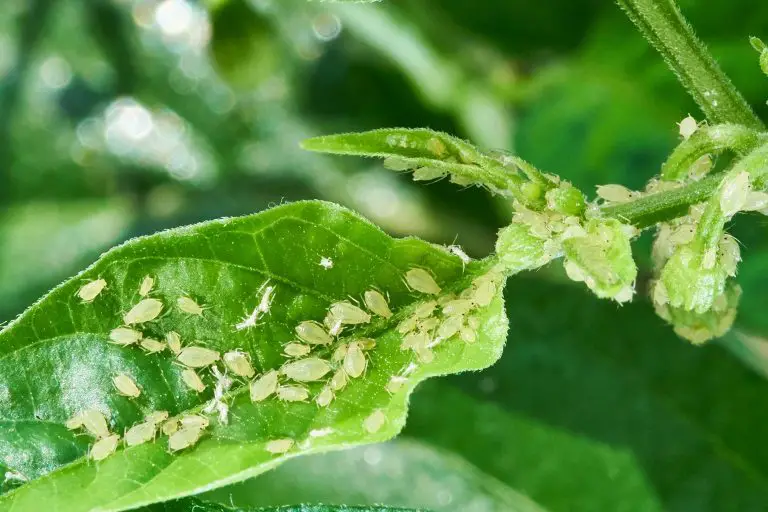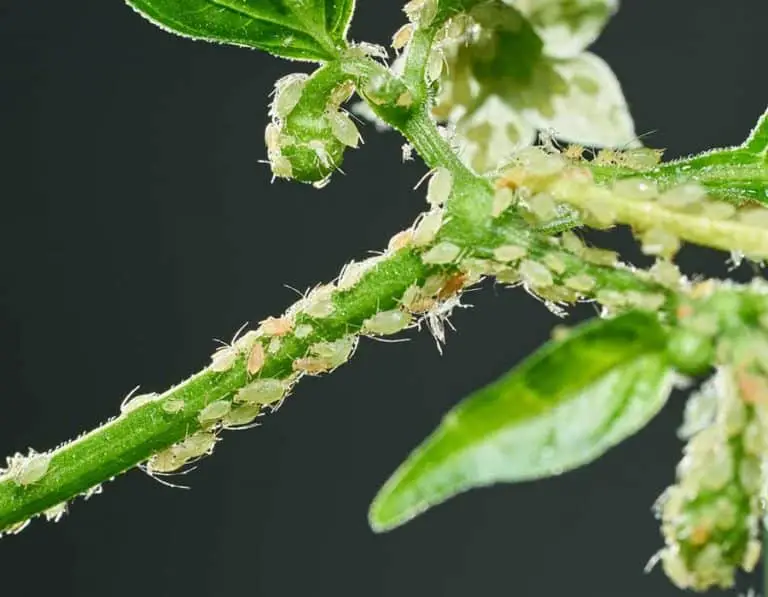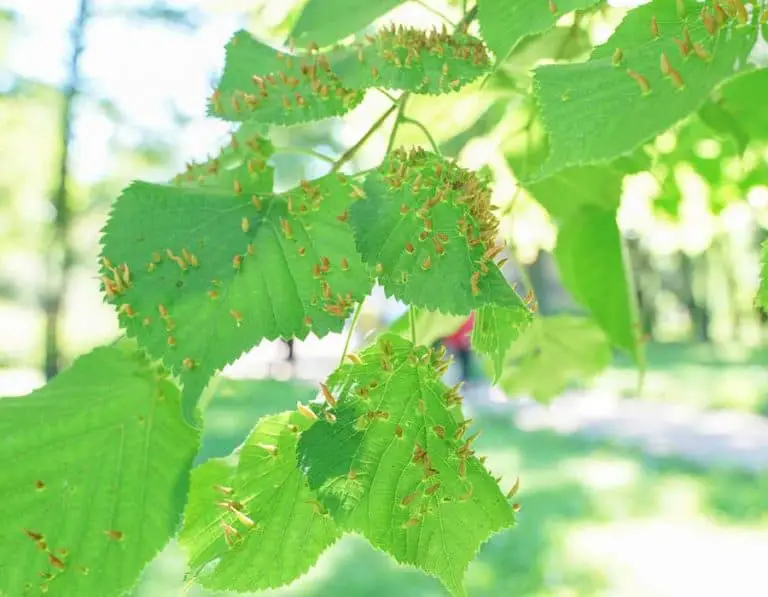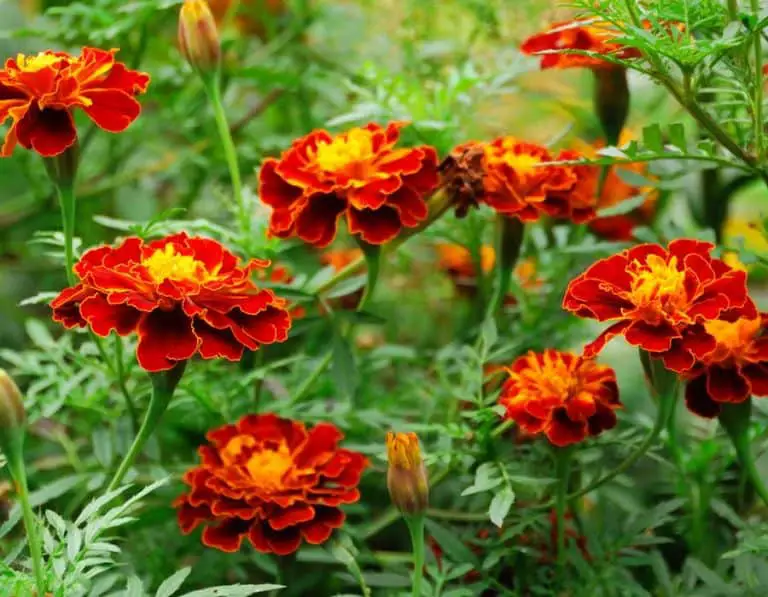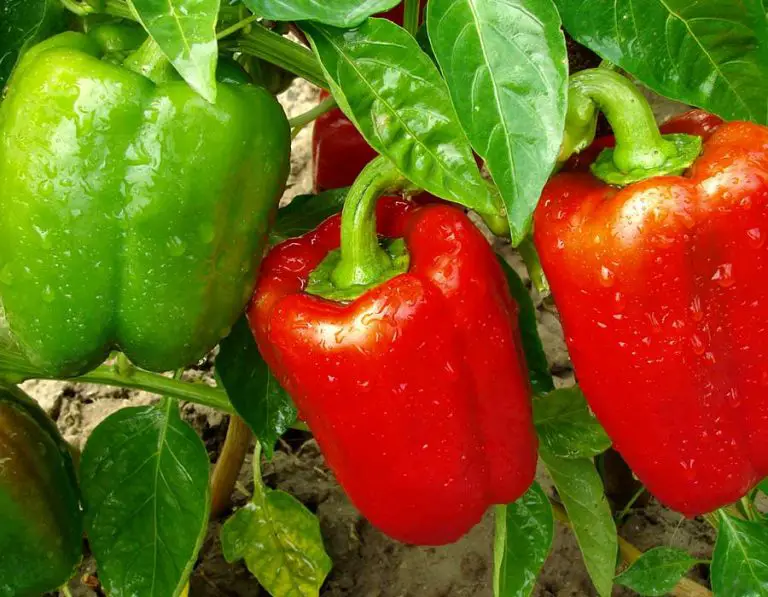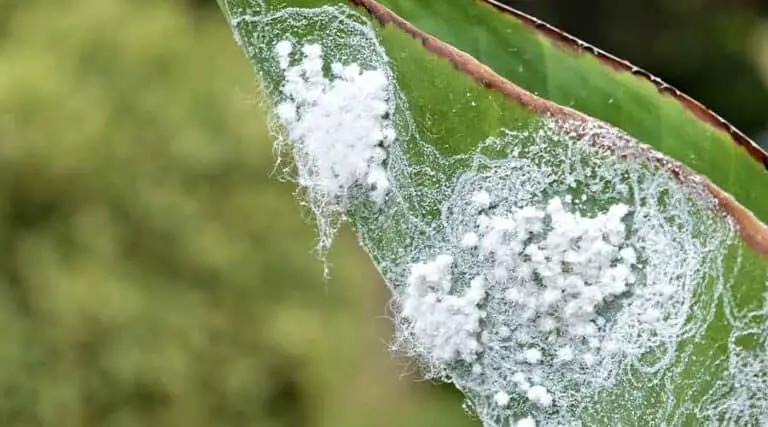How to Get Rid of Aphids on Trees
Along with the majority of other plants, aphids are a common pest to the trees in your garden. You may encounter aphids on large trees, fruit trees, or ornamental trees. Regardless of the affected tree’s size or maturity, an infestation of aphids can have devastating effects on its health.
To get rid of aphids on trees, you can hose them off with water, kill them with a soap solution, or treat the tree with neem oil.
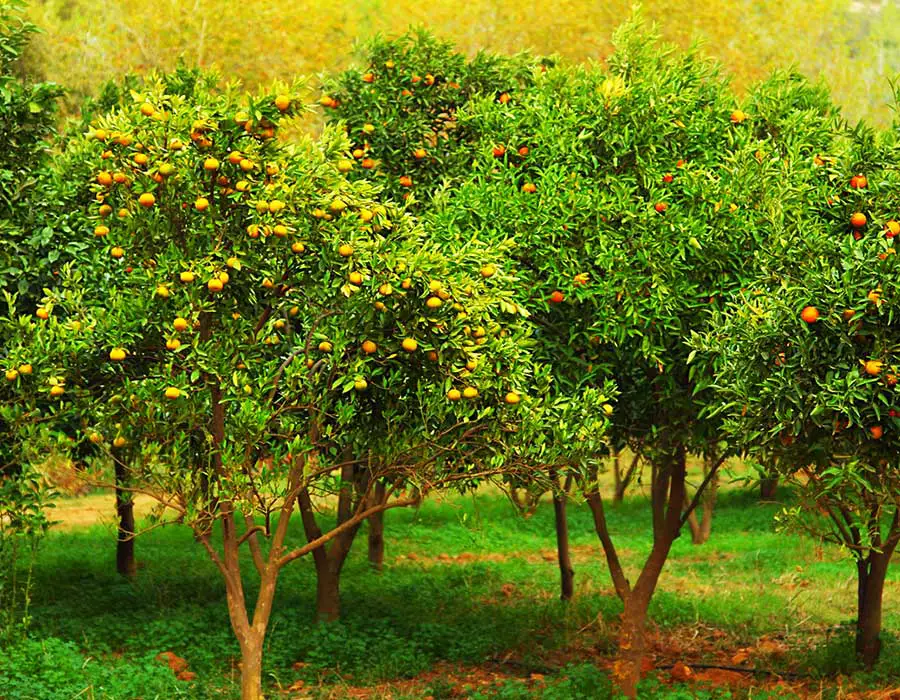
For more severe infestations, you can resort to a chemical pesticide to kill aphids on trees quickly. Planting companion plants, introducing aphid predators, and spreading diatomaceous earth are all effective ways to prevent aphid infestations on trees.
What Are Tree Aphids?
Tree aphids are tiny, soft-bodied insects. They are one of the most common pests to ornamental trees, fruit trees, and any other tree with foliage.
While a few of these insects won’t cause your trees much harm, they can be extremely destructive in high numbers. And, due to their ability to reproduce quickly, a few aphids can turn into a full infestation in very little time.
When present in high numbers, aphids on trees can cause several symptoms including deformation and discoloration of leaves.
Aphids primarily damage trees and other plants through their feeding process. They use their needle-like mouths to pierce into the leaves and stems of trees, before sucking out the tree’s sap.
Not only does this process damage the tree’s foliage, it can also spread fungal disease to an otherwise healthy tree.
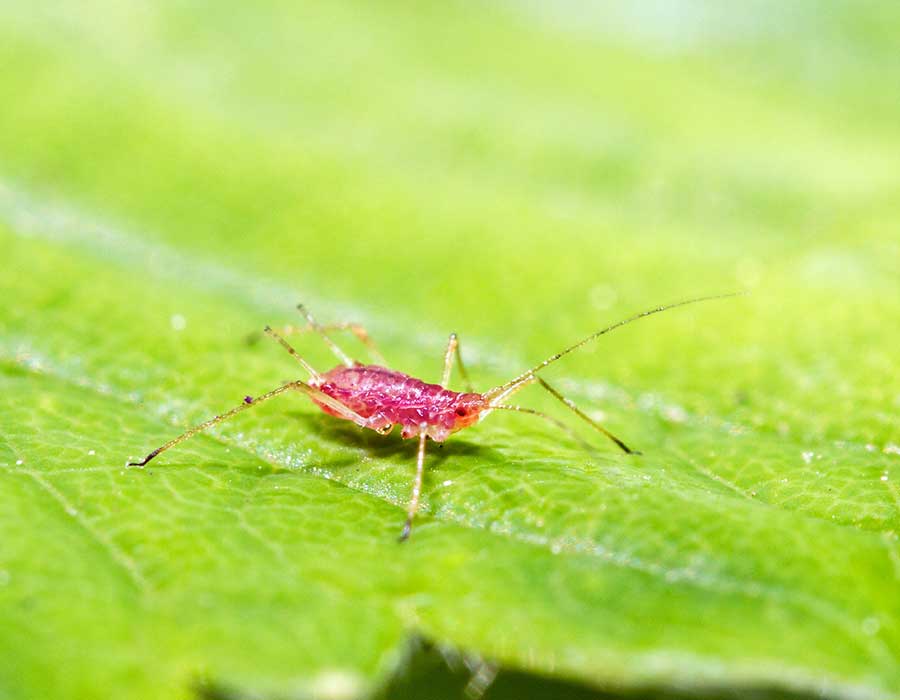
Identifying Aphids on Trees
The easiest way to identify aphids on trees is to look for the insects. Although they are small and hard to spot on their own, it’s easy to spot a full infestation; the aphids tend to cluster in large numbers on the underside of leaves and on branches.
Aphids have oval-shaped bodies, typically measuring to be about ⅛ of an inch long. They come in a variety of colors, including yellow, light green, red, brown, white, gray, or black. Depending on the species, aphids can be both winged and wingless.
In addition to seeing the pests, you can identify aphids on trees by looking for the damage they cause. Signs of aphids on trees include:
- Yellowed or curling leaves
- Deformed leaves or flowers
- Sticky sap residue on leaves or branches
- Black sooty mold on trees
- High presence of ants or ladybugs
Can Aphids Kill a Tree?
Although they can cause a lot of damage, it would take an extremely severe aphid infestation to kill a tree. Small to moderate aphid infestations typically won’t kill trees if you take the right control measures in time.
However, aphids can kill trees indirectly by infecting them with fungal diseases. Fungal tree disease is much more of a concern than the actual aphid infestation itself. Aphids spread fungal disease through their feeding habits; after feeding on an infected tree, they transfer the disease to the next healthy tree they feed on.
Tree diseases can seriously impact the health of the trees, causing death in the worst cases.
Can a Tree Recover From Aphids?
Yes, a tree can recover completely from an aphid infestation provided you treat it early enough in the season. After getting rid of the aphids, even trees with severe defoliation will recover with a flush of new growth. This recovery can take a matter of weeks.
You can boost your tree’s recovery from aphids by giving its root zone a thorough watering. Water to a depth of 18 to 24 inches depending on the size of the tree and its roots. Keep up with this watering routine, allowing the soil to dry between watering sessions.
How to Get Rid of Aphids on Trees Naturally
You can get rid of aphids on trees naturally by hosing them off with water, killing them with a soap solution, or killing them with neem oil. Before resorting to chemical methods of aphid control, it’s best to try out these natural alternatives.
Hose Aphids Off Trees with Water
The most straightforward method to get rid of aphids on trees naturally is to hose them off with water. The jet of water from your hose will dislodge the aphids from the trees; as they are such slow movers, this is typically enough to get rid of the aphids entirely.
Method:
- Using a hose with a high-pressure nozzle, spray all of the aphids off the infested trees. Make sure to spray the whole trunk, along with any branches or leaves that you can reach with your hose.
- Let the leaves of the tree dry throughout the day.
- Repeat the first step in the evening, spraying the tree with water until you see no more aphids.
- Follow up this method with one of the preventative measures listed below to prevent another aphid infestation on the trees.
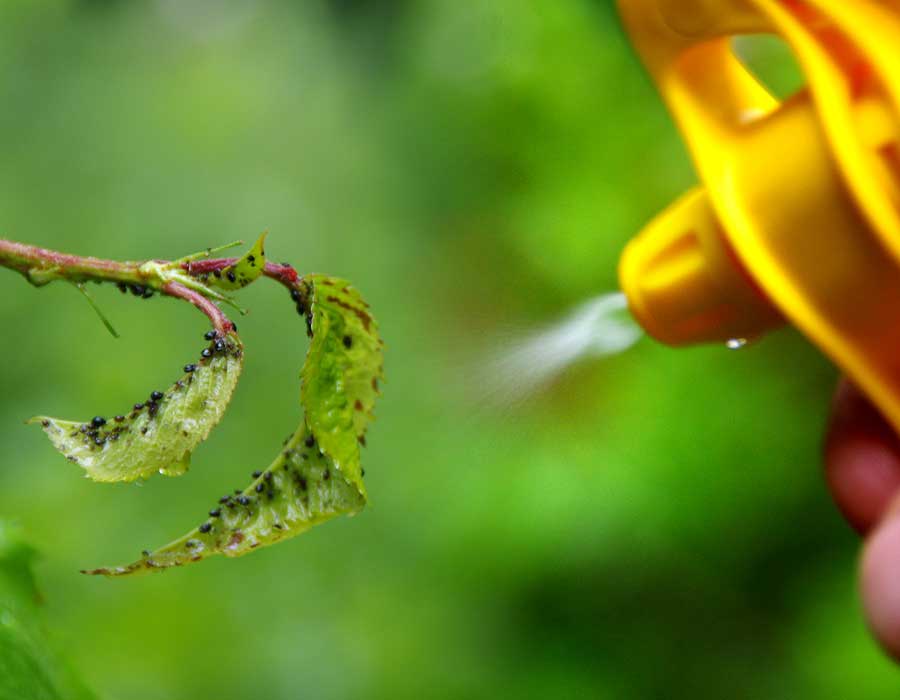
Kill Aphids on Trees with Soapy Water
Another simple natural method to get rid of aphids on trees is to kill them with a solution of soap and water. Soap works to kill aphids in two ways; firstly, the soap smothers the aphids’ exoskeleton, essentially suffocating the aphid to death; secondly, the soap kills aphids by destroying their exoskeleton, causing them to die by dehydration.
Method:
- Make up your own DIY aphid spray for trees by mixing 2 teaspoons of soap into 1 quart of water. While you can use dish soap, the best type of soap to use is pure castile soap. Place the mixture into a clean spray bottle.
- Test your soap and water aphid spray on a small portion of the tree’s foliage. If no damage occurs over the next day or two, you can proceed with treatment of the whole tree.
- Wait for the right conditions to apply your aphid spray; you must apply the spray when temperatures are between 30 and 90°F.
- Spray your soap aphid spray directly onto the aphids on the affected trees. As this solution works as a contact pesticide, it must make direct contact with the aphids to be effective.
- Repeat applications until you kill the last of the aphids. You can enhance the effects of this treatment by combining it with treatments of neem oil; refer to the next section for more information on this aphid treatment.
Kill and Repel Aphids on Trees with Neem Oil
Neem oil is another natural substance that will kill aphids on trees and keep them away. Derived from the seeds of the neem tree, neem oil is a natural insecticide that kills insects like aphids. It will also work to repel aphids from trees for some time after application.
Method:
- Purchase neem oil and make up a solution by combining it with water as per the instructions for your product. Place the neem oil and water solution into a clean spray bottle.
- Spray the neem oil solution onto the trunk, leaves, stems, and branches of the affected trees. To enhance the effectiveness of the solution, treat the trees with a soap spray (as outlined in the previous section) before applying the neem oil.
- After a few weeks, the neem oil should have taken full effect to kill the aphids on the trees. Take note that reapplication will be necessary if there is any heavy rainfall over this period. You can also continue with reapplications to use the neem oil as a repellent against future aphid infestations on trees.
- PURE NEEM OIL COLD PRESSED: Natural Hexane Free Cold Pressed Neem Oil with no additives or dilution Carries all the benefit of Pure Neem Oil.
- CLEAR SKIN: Neem Oil helps clear blemishes and prevent future breakouts. Restores moisture & promote soft and supple skin. Helps calm temporary redness and itchiness due to dryness, eczema, dandruff & more.
- SMOOTH AND SOFT SKIN: Neem Oil's is rich in antioxidants and essential fatty acids and Vitamin E. Great nourishment for your skin, Hair & Nails. Daily use may help diminish appearance of wrinkles, fine lines, and age spots. An Excellent Moisturizer Create your DIY skin care and hair care regimen with Neem Oil.
- NATURAL SOLUTION FOR PLANT SPRAY: Neem oil can help your houseplants vegetables and indoor plants stay healthy and green in the garden. Natural neem oil can be added to your pet shampoo to benefit your pet's coat and skin.
How to Kill Aphids on Trees
In severe cases, it may be necessary to use chemical control products to kill aphids on trees. You should only resort to chemical products to tackle aphid infestations on large trees or to eliminate a widespread infestation.
Kill Aphids on Trees with Contact Pesticide Spray
The first type of pesticide you can use to kill aphids on trees is a non-persistent contact insecticide spray. These products contain pyrethrins, which are chemicals that are toxic to insects like aphids.
For contact pesticides to be effective, they must make direct contact with the insect; the chemicals only persist on foliage for a matter of minutes to hours. You’ll therefore need to spray your chosen contact pesticide directly onto the aphids on your trees. A big advantage of these products is that they pose minimal danger to beneficial pollinators and insects; they also have low toxicity to mammals and birds.
Kill Aphids on Trees with Systemic Pesticide Spray
An alternative type of pesticide you can use to get rid of aphids on trees is a systemic pesticide. These products contain the active ingredients acetamiprid and imidacloprid.
Systemic pesticides work systemically to kill aphids. In other words, the pesticide moves into the tree and circulates around its foliage; when insects like aphids feed on this foliage, they consume the chemicals and die off. These products can continue to kill aphids and other insects for a couple of days to weeks after initial treatment. However, take note that systemic pesticides may also kill off beneficial pollinators and aphid predators.
How to Prevent Aphid Infestations on Trees
Spread Diatomaceous Earth Around Trees
Diatomaceous earth is another natural substance that will get rid of aphids on trees and keep them away. This is a powder made from the ground-up remains of fossilized creatures called diatoms.
It feels powdery to the touch, however, the particles of DE are razor sharp on a molecular level. These particles slice into the bodies of crawling insects like aphids, leaving the insects with lacerations over their bodies. Gradually, the lacerations cause the insects to dry up and die.
Purchase some food-grade diatomaceous earth and sprinkle it around the base of trees and plants in your garden. You can also add a dusting to the actual plants for an extra barrier.
- Natural Product - Composed of 5lbs of 100% ground freshwater diatomaceous earth with absolutely no additives or fillers.
- OMRI Listed - Listed with the Organic Minerals Research Institute, a non-profit organization that reviews products against organic standards.
- Powder Duster Included - Powder duster in the bag for easy and efficient application of diatomaceous earth on animal feed
- Supports a Great Cause - Harris donates 10% of profits to support the local Etowah Valley Humane Society.
- Made in the USA – Mined in Nevada and packaged in Georgia. Does not contain an expiration date.
Plant Companion Plants Near Trees
There are certain plants, known as companion plants, that you can grow near your trees to repel insects like aphids. Companion plants to repel aphids include garlic, onions, sage, oregano, leeks, and chives; all of these plants have a strong odor that aphids avoid, working as a natural method of aphid control.
Introduce Natural Aphid Predators to Garden
Another natural method to control aphids on trees is to introduce populations of these pests’ natural predators. Lady bugs, for example, can eat their own body weight in aphids each day. Other beneficial aphid predators include lacewings and parasitic wasps, as well as birds, particularly wrens. Attract and encourage the populations of these creatures to control aphids on trees long-term.
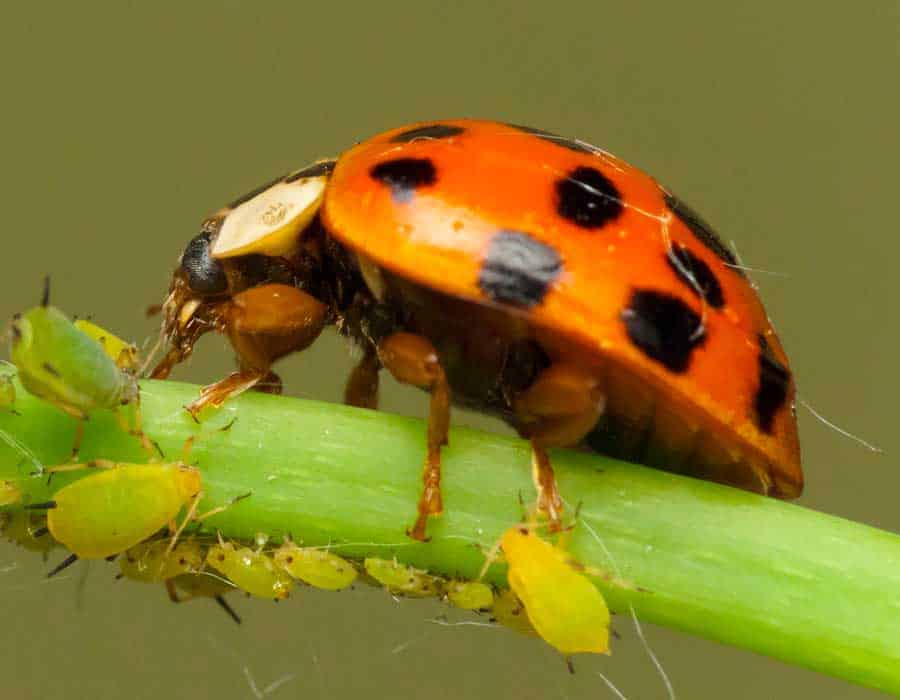
Control Ant Populations
Aphids often form symbiotic relationships with ants; the aphids feed off the trees, and the ants protect them from predators in return for a sweet sugary substance that the aphids excrete. To effectively get rid of aphids on trees, you must also work to control ant populations in your garden.
One way to do this is to set out sticky ant traps around the base of trees. You can also treat trees with a non-repellent insecticide that ants will unknowingly carry back to their nests and share with the rest of the colony, effectively wiping out the entire population.
Conclusion
Aphids are small, sap-sucking insects that can cause damage to trees and other plants. These pests excrete a substance known as honeydew, which can encourage the growth of sooty mold on plant leaves. Aphids also spread plant diseases as they feed.
There are a number of ways to get rid of aphids on trees, including the use of pesticides, diatomaceous earth, and companion plants. You can also introduce natural predators of aphids into your garden, or control ant populations.
Prevention is always the best method of pest control. To prevent aphid infestations on trees, start by planting disease-resistant varieties. Keep trees well-watered and fertilized, and prune away any dead or dying branches. Regularly inspect trees for aphids and remove them by hand if possible. Finally, consider using row covers to protect trees from aphids and other pests.
If you have an aphid infestation on your tree, don’t despair. With a little time and effort, you can get rid of these pests for good.



